Samsung Galaxy Note 10.1 (2014 Edition) Review
by Brian Klug & Anand Lal Shimpi on October 1, 2013 9:00 AM EST- Posted in
- Tablets
- Samsung
- Mobile
- Galaxy Note 10.1
Display
The 2014 Edition features a 10.1-inch 2560 x 1600 Super LCD display. Looking at the subpixel structure of the panel we get an idea for exactly what Super LCD means: RB,GW.
Instead of a standard RGB stripe we get a combination of red, green, blue and white subpixels for each pixel. The white subpixel helps increase light throughput, an obvious problem with these ultra high resolution displays. The downside is that you get a lower subpixel density than a traditional RGB stripe. At these ultra high pixel densities however, the theory is that you wouldn’t notice the difference - hopefully making the power savings by having better light transmission, particularly when displaying lots of white (e.g. web pages), worth it.
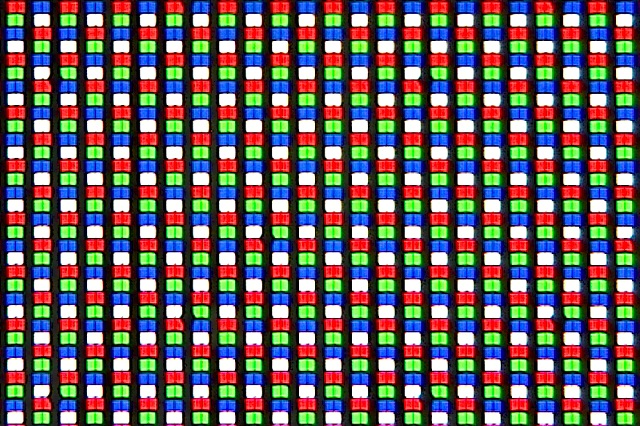
In practice the display looks pretty good, although a carefully trained eye will be able to recognize that this isn’t a standard RGB stripe. I quickly realized something was different about the display, something I later verified when looking at the subpixel structure.
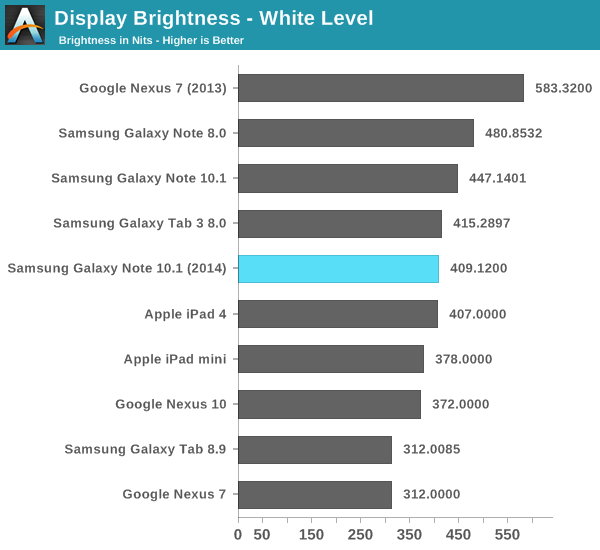
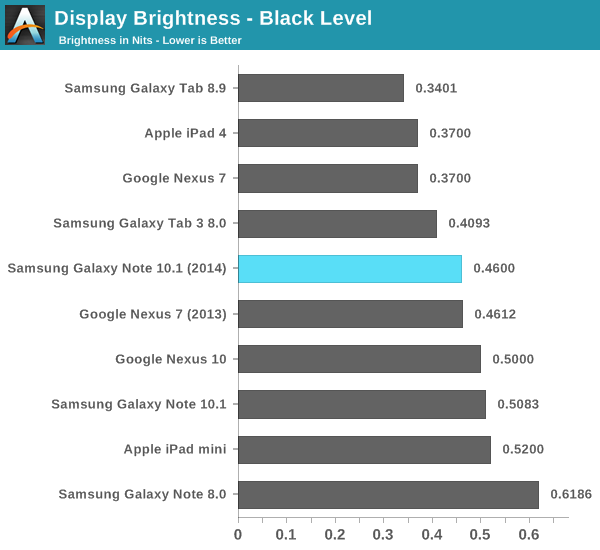
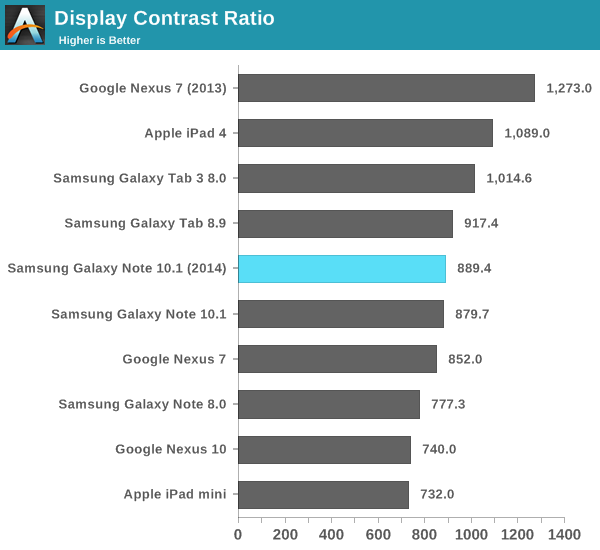
Color accuracy is pretty decent on the Note 10.1’s display. As always I’m reporting color data using Samsung’s Movie mode, which remains the most accurate setting of those offered. Grayscale performance is excellent, but our GMB and saturations tests put the Note 10.1 on par with the original Nexus 7. It’s definitely a better calibrated display than any other Samsung Galaxy Note tablet we’ve reviewed. Not quite on par with the new Nexus 7, but getting very close.
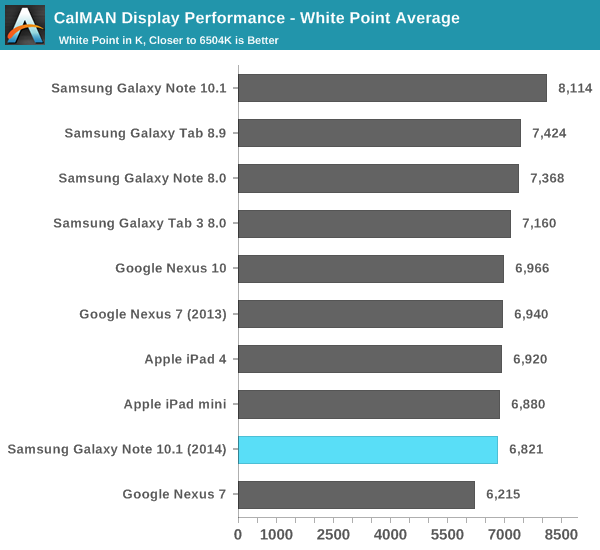
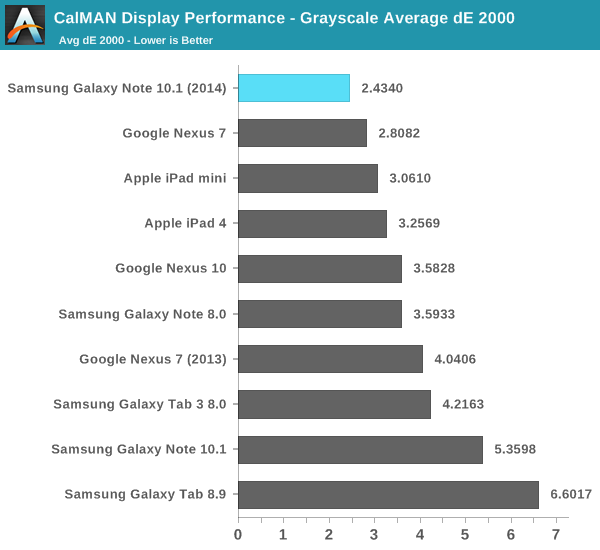
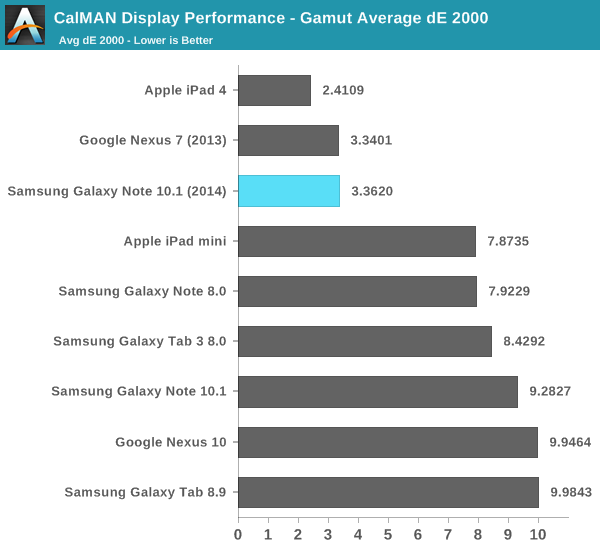
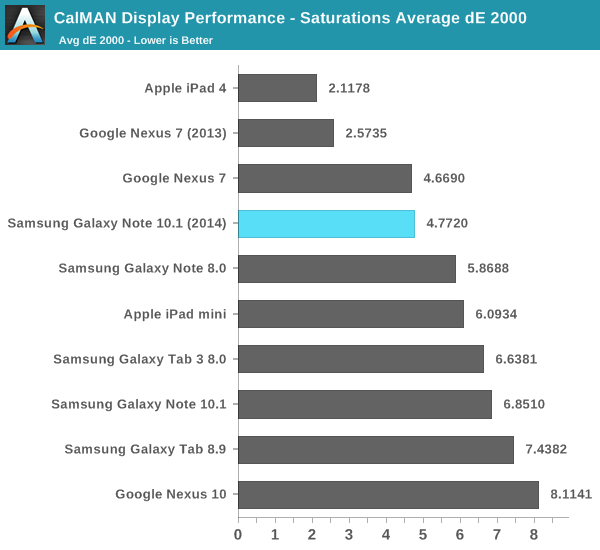
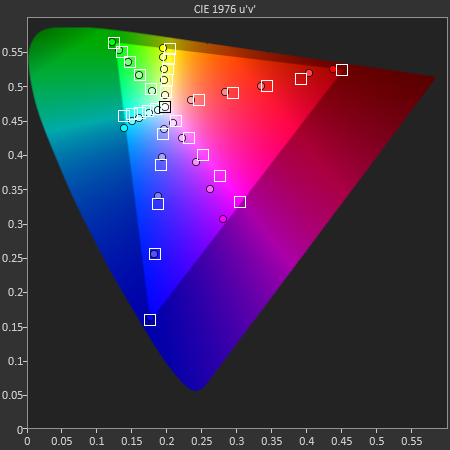
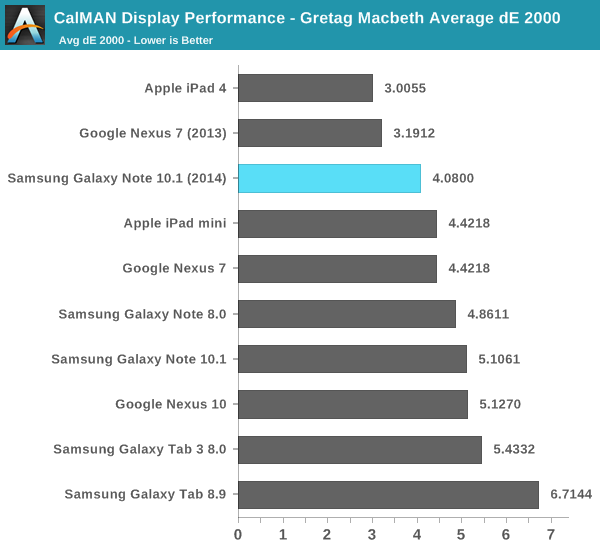

Camera
The 2014 Edition features a rear facing 8MP camera with AF and LED flash and a 2MP front facing camera. Image quality out of the rear camera was pretty good for a tablet. I took some photos using the tablet and tossed them in the gallery below, as well as embedded a sample 1080p video recorded using the tablet.
Battery Life & Charging
The Galaxy Note 10.1 (2014 Edition) ships with an integrated (non-removable) 31Wh battery, that’s substantially smaller than the iPad 4’s 42.5Wh battery - helping it maintain a more svelte figure. The question is how power efficient the combination of RB,GW panel and Exynos 5420 are in combination with one another.
We’ll start with our typical WiFi web browsing battery life test. Here we see a good combination of regular spikes in CPU usage with idle time, hopefully simulating constant, reasonably paced usage.
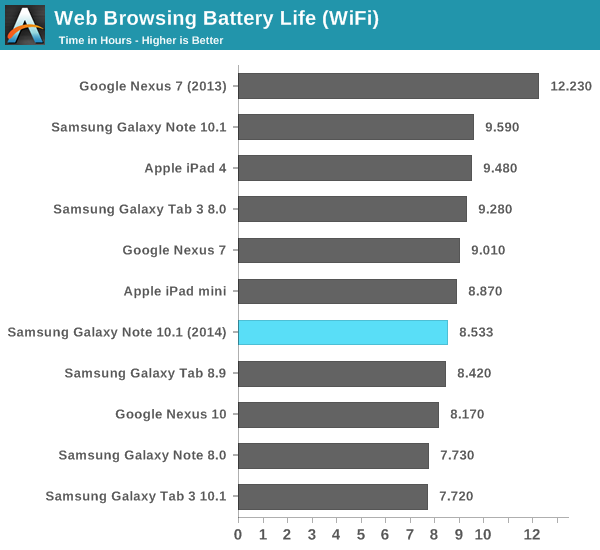
The 2014 Edition does a bit better than the Nexus 10, but clearly worse than the original Note 10.1 (and obviously worse than the much smaller Nexus 7). There’s not much you can do here other than to point out that we’re talking about an extremely high resolution panel, with an extremely power hungry SoC. The fact that we’re talking about more cores running at a higher frequency than the Exynos 5250 used in the Nexus 10 is good news, but Exynos 5420 also enjoys the benefits of being on Samsung’s 28nm LP process as well.
The video playback story is much better however. With the power hungry Cortex A15 cores able to power down (and hopefully remain there), we’re really testing the display and video decode engines here:
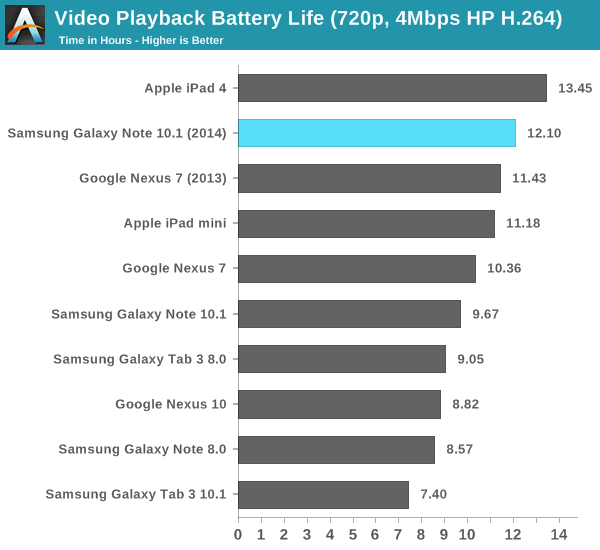
The Note 10.1 beats the new Nexus 7 and is only 10% behind the iPad 4, despite having a much smaller battery.
Like the Nexus 10, the Galaxy Note 10.1 (2014 Edition) takes an incredible amount of time to charge with the bundled 2A charger. A full charge from 0 to 100% took just over 7 hours.
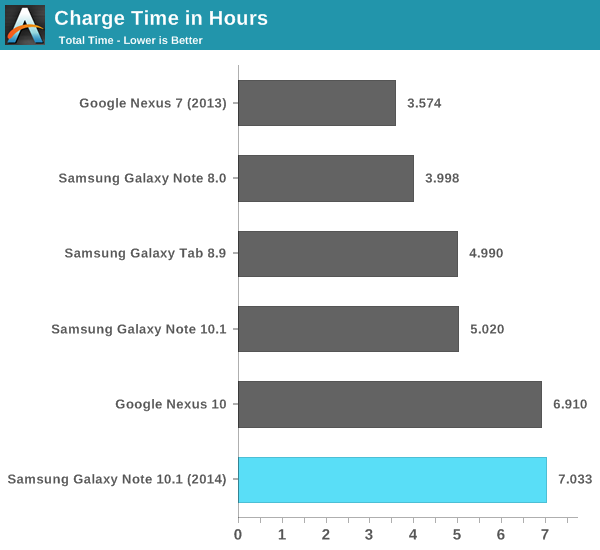
















97 Comments
View All Comments
misfit410 - Thursday, October 3, 2013 - link
I have an iPad 3 and an iPad mini, my experience is not smooth on either.. can't even browse engadget or Gawker without crashing safari.badcode - Tuesday, October 8, 2013 - link
I thought that was only occurring on my ipad 1 because it was so old. Now I know I will either wait for a Tegra 4 tablet or get a surface pro 2. Thanks for the infocrankerchick - Saturday, October 12, 2013 - link
Late reading the review, but I wish you guys had touched on how the device runs in actual use. Benchmarks are nice, but some want to know how laggy the tablet feels using it, especially in multi-window mode or with the stylus. That's what makes this tablet unique, and it doesn't seem to be touched on at all.sundragon - Wednesday, October 2, 2013 - link
Interesting as this is typical excuse I read when people blast Apple for being slow but when when someone introduces a faster Android based device, the same excuse isn't used.A 1.3 GHz ARMv8 based dual core CPU (designed by Apple, fabbed by Samsung) is beating a 1.8GHz Samsung ARMv7 A15 quad core CPU (designed by ARM, fabbed by Samsung).
All the excuses for javascript, multi-threaded performance, etc are BS.
Will you use the same excuse when Samsung introduces an ARMv8 64-bit Exynos next year in the Samsung Galaxy 5?
If it beats the 5S willl ya all be making excuses for Android being different from iOS?
I think not, I think admitting to being biased is a bit better than making excuses...
P.S. the chart Anand created to show the cheating on the Android side of things (except Motorola/Google) is telling as to the business ethics of the companies listed...
Now go polish a turd and try to sell it to me...
IUU - Thursday, October 3, 2013 - link
Apple is not slow but its intentions are sinister.I would rather buy "a polished turd" from any other "incompetent Apple rival" than let Apple destroy the progress of computing.
And by the way... Apple has offered a palatable computing performance only with its recent mobile products. Yet, they can't get over the fact that they actually had to incorporate performance parts into their devices, and they started to iterate the same old crap about "user experience", hoping they ultimately sell outdated tech with high profits.
I won't say more, I am fiercely anti-apple, but there are some very good reasons for this, whether you want to believe it or not.
ESC2000 - Sunday, October 6, 2013 - link
Or to put it more simply, competition is good for us all. Consumers would be screwed if everyone bought only apple, but I get the sense from the rabid apple lovers that ideally we'd all use apple products for everything. Thank God that's only a fantasy. Apple's awesome hardware is totally wasted on its closed down gimp OS.jasonelmore - Friday, October 4, 2013 - link
That's the thing, 90% of the gains werent from amazin soc design, it was from moving to a 64 bit instruction set, which dropped laggy legacy support of the past 20 years that slowed things. Moving forward, all these oem's will do the same, and that's when we truly see how good apple's new soc is.ddriver - Tuesday, October 1, 2013 - link
Not really, while it is not a reference ARM design, apple have only modified it slightly, but it is still a conventional arm v8 chip.Note that the benchmarks the 5s is better at are:
1 - JS benchmarks using different browsers with different JS engine implementations
2 - single threaded, which plays in favor of apple, since they have lower core count
The snapdragon 800 is actually considerably faster in HPC workloads. The A7 has better single threaded performance, but not that much higher to make up for it...
Naturally, I don't expect from someone with your screen name to be capable of objectivity. And no, I don't own a single samsung device, so I am not biased even a little bit. If anything, I am a Dell and Asus guy...
MrSpadge - Tuesday, October 1, 2013 - link
I really dislike Apples closed software environment - but you have to give credit where it's due. The 2-core A7 at 1.3 GHz beating this 4+4 core with A15's at a maximum of 1.8 GHz is really impressive. Apple is doing something right here! And seriously, who cares about HPC workloads on a tablet?ddriver - Tuesday, October 1, 2013 - link
So why do you need high performance on a tablet if high-performance computing is not needed on a tablet(or a phone for that matter)?I mean it is either that we need and care about performance or not. If we don't why would a faster chip be considered an advantage? Because it can do something in 0.002 seconds rather than 0.0025?